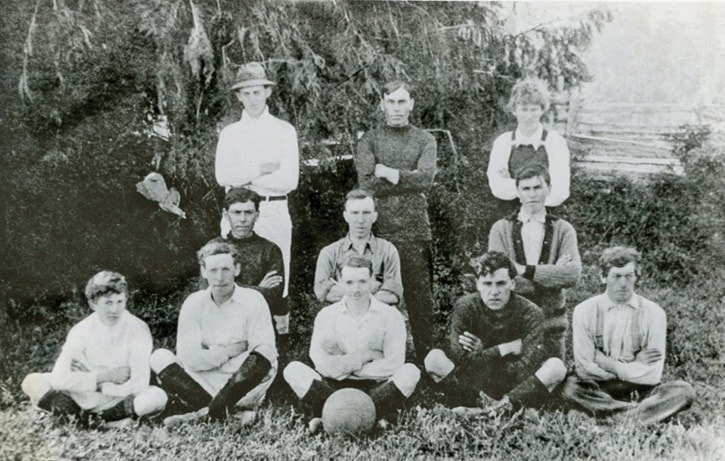While we didn’t have the carefully-tended playing fields or concessions back a century ago, we did have the enthusiastic players and loyal fans.
Sports have always been an extremely important part of life in Sooke. This team of Sooke fellows posed at a field in Metchosin in 1915.
Several of the names will be familiar to readers as they are remembered by road names or geographical features. Standing at left is Bert Mugford. Eldest son of the Mugford family who built the boarding house that stood at the corner of Church and Sooke Roads, Bert became a wireless operator and served many years on the CGS vessel Estevan.
Four of the men in the photo are the sons of matriarch Mary George and her husband Harry George Sr who was lost at sea when the sealing schooner Walter Earl went down in 1895. Three of Mary George’s four sons in turn served as chief in the years 1930-62.
Danny George is at centre rear; he became well-known fishing with his seiners Saseenos and Atalasco, and mentoring a number of youths as crew during his many seasons fishing for salmon.
Peter Lannan, right rear, was one of the sons of the Lannan family who lived on the waterfront and farmed throughout the fields and forests that were to become the subdivision of Saseenos.
Centre row, first is Louis George, who with his wife Agnes was stationed on the Sooke fishtrap as watchman for many years. While we’re not sure of the next player, it may have been a member of the Davidson family of Otter Point. Last in the row is Eddie George, youngest of the four brothers. Eddie’s daughter Jean Whitford, a T’Sou-ke Elder, and youngest daughter Karen are both well-known in the community today.
In the front is Arthur Stuart whose family pre-empted on Otter Point Road. Tommy Wright is next, he married schoolteacher Winnifred McGibbon. With the soccer ball is Eric Pyrah; his family had a farm which was known for producing hams. Harry George, another of Mary’s sons is next; later on, he became well-known for enjoying touring with his motorbike and sidecar.
The final figure on the right is Tommy Cartwright, a son of William Cartwright and Mary Finlay, who had come here in 1872.
Mary Finlay was a daughter of an early HBC trader James Finlay, stationed in Nanaimo, and the pioneering couple raised a large family on their East Sooke farm.
Getting to games was a challenge in itself in those days – there weren’t many touring cars around, and often travel was by footback or horse and buggy.
Elida Peers, Historian
Sooke Region Museum
